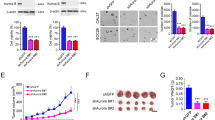Abstract
The Aurora kinases play a critical role in mitosis and have been suggested as promising targets for cancer therapy due to their frequent overexpression in a variety of tumors. Compared with established inhibitors of cell division such as the anti-tubulins, novel agents target mitotic enzymes and show similar efficacy but with fewer side effects. Several small-molecule inhibitors of Aurora kinases have been developed as anticancer agents, some of which have progressed to early clinical evaluation. Here we identified 3-hydroxyflavone as a novel Aurora B inhibitor through high throughput screening. 3-Hydroxyflavone showed potent inhibition to Aurora B with the IC50 on a nanomolar basis in the enzyme-based kinase activity assay. In the cell-based western blotting analysis, 3-hydroxyflavone dramatically decreased the phosphorylation level of Histone H3 on the site of serine 10, demonstrating the potent endogenous Aurora B activity inhibition in cell level. The followed cell image analysis provided the consist result. To make it clear whether 3-hydroxyflavone inhibited Aurora B by direct binding or not, SPR analysis was carried out to measure the affinity of interaction between Aurora B protein and 3-hydroxyflavone and the result proved the binding with high affinity. Usually Aurora activity suppression induced cancer cell proliferation inhibition. Colony formation and cell viability with/without treatment of 3-hydroxyflavone were measured using CCK-8. The growth suppression under 3-hydroxyflavone present and the growth recovery after being released gave strong evidence that presence of 3-hydroxyflavone efficiently inhibited the fast growth of cancer cells.





Similar content being viewed by others
Abbreviations
- HTS:
-
High throughput screening
- MBP:
-
Myelin basic protein
- PhH3(Ser10):
-
Phospho-histone H3 (Ser 10)
- IF:
-
Immunofluorescence
- SPR:
-
Surface plasmon resonance
References
Lengauer C, Kinzler KW, Vogelstein B (1998) Genetic instabilities in human cancers. Nature 396:643–649. doi:10.1038/25292
Nigg EA, Blangy A, Lane HA (1996) Dynamic changes in nuclear architecture during mitosis: on the role of protein phosphorylation in spindle assembly and chromosome segregation. Exp Cell Res 229:174–180. doi:10.1006/excr.1996.0356
Andrews PD (2005) Aurora kinases: shining lights on the therapeutic horizon? Oncogene 24:5005–5015. doi:10.1038/sj.onc.1208752
Carmena M, Earnshaw WC (2003) The cellular geography of aurora kinases. Nat Rev Mol Cell Biol 4:842–854. doi:10.1038/nrm1245
Adams RR, Carmena M, Earnshaw WC (2001) Chromosomal passengers and the (aurora) ABCs of mitosis. Trends Cell Biol 11:49–54. doi:10.1016/S0962-8924(00)01880-8
Nigg EA (2001) Mitotic kinases as regulators of cell division and its checkpoints. Nat Rev Mol Cell Biol 2:21–32. doi:10.1038/35048096
Katayama H, Brinkley WR, Sen S (2003) The Aurora kinases: role in cell transformation and tumorigenesis. Cancer Metastasis Rev 22:451–464. doi:10.1023/A:1023789416385
Bischoff JR, Anderson L et al (1998) A homologue of Drosophila aurora kinase is oncogenic and amplified in human colorectal cancers. EMBO J 17:3052–3065. doi:10.1093/emboj/17.11.3052
Sen S, Zhou H, White RA (1997) A putative serine/threonine kinase encoding gene BTAK on chromosome 20q13 is amplified and overexpressed in human breast cancer cell lines. Oncogene 14:2195–2200. doi:10.1038/sj.onc.1201065
Warner SL, Bearss DJ et al (2003) Targeting Aurora-2 kinase in cancer. Mol Cancer Ther 2:589–595
Katayama H, Ota T et al (1999) Mitotic kinase expression and colorectal cancer progression. J Natl Cancer Inst 91:1160–1162. doi:10.1093/jnci/91.13.1160
Keen N, Taylor S (2004) Aurora-kinase inhibitors as anticancer agents. Nat Rev Cancer 4:927–936. doi:10.1038/nrc1502
Marumoto T, Zhang D, Saya H (2005) Aurora-A - a guardian of poles. Nat Rev Cancer 5:42–50. doi:10.1038/nrc1526
Sasai K, Katayama H et al (2004) Aurora-C kinase is a novel chromosomal passenger protein that can complement Aurora-B kinase function in mitotic cells. Cell Motil Cytoskeleton 59:249–263. doi:10.1002/cm.20039
Yan X, Cao L et al (2005) Aurora C is directly associated with Survivin and required for cytokinesis. Genes Cells 10:617–626. doi:10.1111/j.1365-2443.2005.00863.x
Ditchfield C, Johnson VL et al (2003) Aurora B couples chromosome alignment with anaphase by targeting BubR1, Mad2, and Cenp-E to kinetochores. J Cell Biol 161:267–280. doi:10.1083/jcb.200208091
Harrington EA, Bebbington D et al (2004) VX-680, a potent and selective small-molecule inhibitor of the Aurora kinases, suppresses tumor growth in vivo. Nat Med 10:262–267. doi:10.1038/nm1003
Hauf S, Cole RW et al (2003) The small molecule Hesperadin reveals a role for Aurora B in correcting kinetochore-microtubule attachment and in maintaining the spindle assembly checkpoint. J Cell Biol 161:281–294. doi:10.1083/jcb.200208092
Acknowledgments
This work was supported by the National 973 program of China (2004CB518605), the National 863 project of China (2006AA020501), the National Key Sci-Tech Special Project of China (2008ZX10002-020), the Project of the Shanghai Municipal Science and Technology Commission (03dz14086) and the National Natural Science foundation of China (30024001, 30771188).
Author information
Authors and Affiliations
Corresponding author
Additional information
Qingyu Lang and Haoxing Zhang contributed equally to the work.
Rights and permissions
About this article
Cite this article
Lang, Q., Zhang, H., Li, J. et al. 3-Hydroxyflavone inhibits endogenous Aurora B and induces growth inhibition of cancer cell line. Mol Biol Rep 37, 1577–1583 (2010). https://doi.org/10.1007/s11033-009-9562-y
Received:
Accepted:
Published:
Issue Date:
DOI: https://doi.org/10.1007/s11033-009-9562-y




